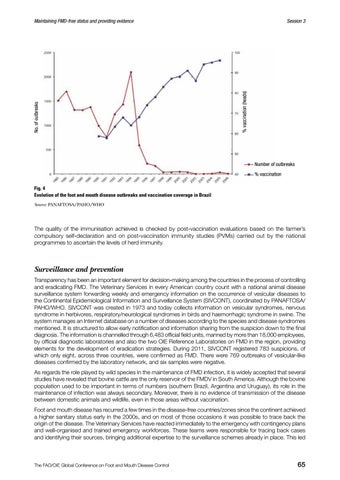Session 3
% vaccination (heads)
No. of outbreaks
Maintaining FMD-free status and providing evidence
Number of outbreaks % vaccination Fig. 4 Evolution of the foot and mouth disease outbreaks and vaccination coverage in Brazil Source: PANAFTOSA/PAHO/WHO
The quality of the immunisation achieved is checked by post-vaccination evaluations based on the farmer’s compulsory self-declaration and on post-vaccination immunity studies (PVMs) carried out by the national programmes to ascertain the levels of herd immunity.
Surveillance and prevention Transparency has been an important element for decision-making among the countries in the process of controlling and eradicating FMD. The Veterinary Services in every American country count with a national animal disease surveillance system forwarding weekly and emergency information on the occurrence of vesicular diseases to the Continental Epidemiological Information and Surveillance System (SIVCONT), coordinated by PANAFTOSA/ PAHO/WHO. SIVCONT was created in 1973 and today collects information on vesicular syndromes, nervous syndrome in herbivores, respiratory/neurological syndromes in birds and haemorrhagic syndrome in swine. The system manages an Internet database on a number of diseases according to the species and disease syndromes mentioned. It is structured to allow early notification and information sharing from the suspicion down to the final diagnosis. The information is channelled through 6,483 official field units, manned by more than 18,000 employees, by official diagnostic laboratories and also the two OIE Reference Laboratories on FMD in the region, providing elements for the development of eradication strategies. During 2011, SIVCONT registered 783 suspicions, of which only eight, across three countries, were confirmed as FMD. There were 769 outbreaks of vesicular-like diseases confirmed by the laboratory network, and six samples were negative. As regards the role played by wild species in the maintenance of FMD infection, it is widely accepted that several studies have revealed that bovine cattle are the only reservoir of the FMDV in South America. Although the bovine population used to be important in terms of numbers (southern Brazil, Argentina and Uruguay), its role in the maintenance of infection was always secondary. Moreover, there is no evidence of transmission of the disease between domestic animals and wildlife, even in those areas without vaccination. Foot and mouth disease has recurred a few times in the disease-free countries/zones since the continent achieved a higher sanitary status early in the 2000s, and on most of those occasions it was possible to trace back the origin of the disease. The Veterinary Services have reacted immediately to the emergency with contingency plans and well-organised and trained emergency workforces. These teams were responsible for tracing back cases and identifying their sources, bringing additional expertise to the surveillance schemes already in place. This led
The FAO/OIE Global Conference on Foot and Mouth Disease Control
65
















